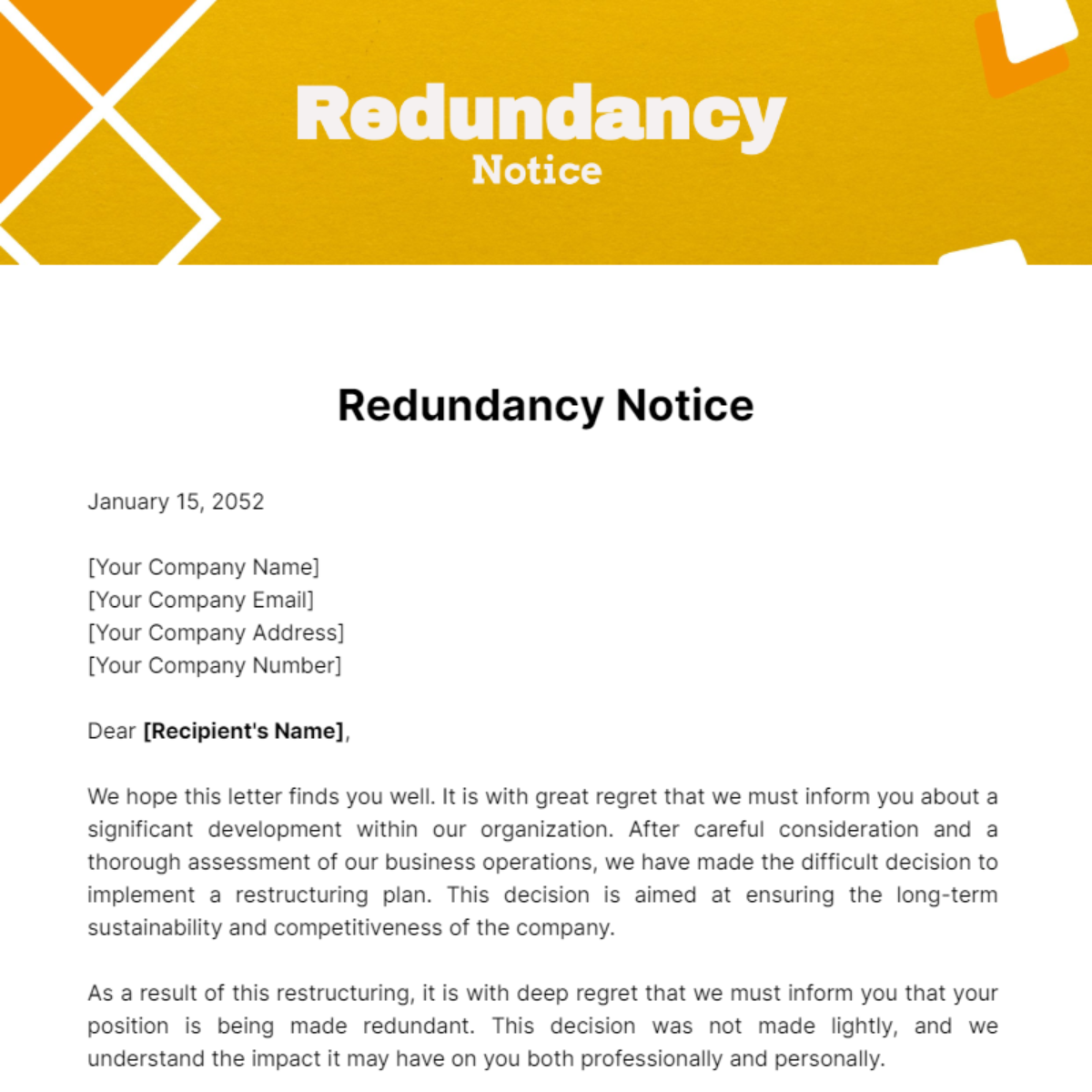Your Rights to Redundancy If Company Goes Bust: UK Employee Protections
Wiki Article
Exploring the Operational Characteristics of Firm Redundancy and Its Long-Term Sustainability

Redundancy Techniques for Business Connection
In order to ensure nonstop operations, companies must implement reliable redundancy methods for company connection. Redundancy in this context describes the replication of critical elements or functions within a system to mitigate the impact of possible failures. By incorporating redundancy approaches, organizations can enhance their durability versus interruptions brought on by different elements such as all-natural disasters, equipment failures, or cyber-attacks.
One typical redundancy strategy is the application of back-up systems and information storage space solutions. This entails creating matches of necessary data and systems that can be turned on in instance of a key system failure. Furthermore, organizations can establish repetitive communication networks and source of power to keep connection and operations during unpredicted events.
Furthermore, cross-training staff members to do several duties within the company can act as a valuable redundancy strategy. If essential employees are unavailable due to illness or other reasons, this guarantees that necessary tasks can still be lugged out also. In general, effective redundancy approaches are essential for businesses to copyright operational continuity and minimize the effect of potential disruptions.
Influence of Redundancy on Business Resilience
Offered the important duty redundancy approaches play in guaranteeing organization continuity, exploring the influence of redundancy on business strength becomes essential for understanding the all natural operational dynamics of a company. Redundancy, when tactically applied, can dramatically add to boosting an organization's durability in the face of unexpected obstacles.Moreover, redundancy can reinforce staff member morale and self-confidence, knowing that there are backup plans in position to attend to unforeseen conditions. This sense of safety and security can lead to raised productivity and a more positive work environment. Furthermore, redundancy can cultivate advancement and imagination within an organization as workers feel equipped to take calculated dangers, recognizing that there is a safeguard to support them in situation of failing. In general, the impact of redundancy on business resilience is profound, shaping the long-lasting sustainability and success of a firm.
Stabilizing Effectiveness and Adaptability in Redundancy
Accomplishing a harmonious balance between operational efficiency and adaptive adaptability is a critical difficulty in the calculated implementation of redundancy within organizations. Effective procedures are essential for preserving efficiency and cost-effectiveness, guaranteeing that sources are used efficiently. However, too much emphasis on effectiveness redundancy pay if company goes bust alone can bring about strength, making it hard for organizations to adjust to unexpected modifications or challenges. On the various other hand, versatility enables companies to respond nimbly to developing situations, fostering innovation and durability. Yet, excessive flexibility without a strong operational structure can lead to ineffectiveness and disparity.To stabilize effectiveness and adaptability in redundancy preparation, companies should meticulously evaluate their operational demands, market dynamics, and strategic objectives. Eventually, finding the best balance between efficiency and flexibility is vital for developing a lasting and resilient organization in the face of uncertainty.
Long-Term Sustainability Through Redundancy Preparation
To make certain enduring practicality and stability, companies must purposefully straighten their redundancy preparation with lasting sustainability goals, thereby balancing operational performance with flexible flexibility. Companies must view redundancy not as a reactive solution to instant troubles however as an aggressive approach for long-term success.
Aggressive Steps for Lasting Firm Workflow
Just how can firms proactively improve their operational sustainability for long-term success? Implementing positive procedures is vital for companies aiming to ensure sustainable operations. One vital technique is to invest in innovation and advancement to simplify procedures, decrease waste, and remain competitive in the market. Taking on sustainable techniques such as minimizing power consumption, lessening carbon footprint, and enhancing source utilization can not just benefit the setting however also lead to set you back financial savings over time.In addition, fostering a society of constant improvement and discovering within the company can boost versatility to altering market problems and client demands. Urging worker involvement in decision-making procedures and supplying possibilities for professional development can boost spirits, efficiency, and total performance. Establishing clear goals, keeping track of key performance signs, and routinely reviewing progress are vital parts of proactive sustainability administration.
Working together with vendors, consumers, and various other stakeholders to advertise lasting methods throughout the supply chain can create a ripple impact of favorable influence - redundancy pay if company goes bust. By taking positive actions towards functional sustainability, firms can construct resilience, drive technology, and secure their long-term success in an ever-evolving company landscape
Conclusion

In the realm of organizational monitoring, the critical implementation of firm redundancy stands as a pivotal yet complex technique that demands a delicate balance between operational efficiency and lasting stability. By studying the functional dynamics that underpin firm redundancy and examining its more comprehensive ramifications for organizational durability and flexibility, a nuanced understanding of how redundancy strategies can form the future trajectory of a business begins to unravel.Given the important duty redundancy techniques play in making sure service continuity, exploring the effect of redundancy on business resilience comes to be vital for recognizing the holistic functional dynamics of a company. In general, the influence of redundancy on organizational strength is extensive, shaping the long-lasting sustainability and success of a firm.
In final thought, comprehending the functional characteristics of firm redundancy is vital for making certain lasting sustainability.
Report this wiki page